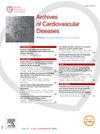心血管疾病高危人群戒烟的性别特异性预测因素
IF 2.2
3区 医学
Q2 CARDIAC & CARDIOVASCULAR SYSTEMS
引用次数: 0
摘要
吸烟是心血管疾病(CVD)的主要风险因素,尤其是对女性而言,但戒烟(SC)可降低甚至消除男女的吸烟风险。我们利用一个全国性的戒烟服务数据库,旨在确定具有心血管疾病风险因素(CVRF)或心血管疾病的男性和女性吸烟者的戒烟预测因素。我们从法国 CDTnet 数据库中进行了一项回顾性研究。纳入标准为年龄≥18岁,CVRF(体重指数≥25 kg/m2、高血压、糖尿病、高胆固醇血症)或CVD(心肌梗死(MI)或心绞痛、中风、外周动脉疾病[PAD])≥1个。通过呼出的一氧化碳< 10 ppm确认自我报告的戒烟情况(连续≥28天)。逻辑回归分析评估了 SC 与社会人口学、医学特征和吸烟情况之间的关联。在 36 864 名冠心病高危吸烟者中,女性戒烟率略低于男性(52.6% [n = 8 102] vs 55.0% [n = 11 848],P < 0.001)。男女戒烟率最低的相关因素是糖尿病、呼吸系统疾病和精神疾病、使用抗焦虑药/抗抑郁药以及吸食大麻。在女性中,与戒烟相关的因素是患有心肌梗死或心绞痛和服用避孕药,而与持续吸烟相关的因素是酒精紊乱和大量吸烟。在男性中,超重与戒烟之间存在正相关关系,而首次就诊时同时吸食香烟和电子烟、患有烟草相关疾病(癌症和心内膜缺损)以及接受阿片类药物替代治疗则与持续吸烟有关。最后,在男女受试者中,与戒烟相关的因素包括:年龄≥65岁、拥有文凭、有工作、自我推荐或受周围人鼓励、曾经≥1次戒烟尝试、每天吸烟量≤20支、受益于SC药物处方以及≥4次随访。总之,我们的研究结果表明,根据社会人口学、医学和吸烟行为特征以及针对不同性别的SC方法,对高CV风险吸烟者进行SC强化管理具有重要意义。本文章由计算机程序翻译,如有差异,请以英文原文为准。
Sex-specific predictive factors of smoking cessation in subjects at high cardiovascular risk
Smoking is a major risk factor for cardiovascular diseases (CVD), in particular in women, but smoking cessation (SC) reduces or even cancels the risk for both sexes. Using a nationwide SC services database, we aimed to determine the predictive factors of SC in men and women smokers with CV risk factors (CVRF) or CVD. A retrospective study from the French CDTnet database was conducted. Inclusion criteria were age ≥ 18 years, and ≥ 1 CVRF (Body Mass Index ≥ 25 kg/m2, hypertension, diabetes, hypercholesterolemia) or CVD (myocardial infarction (MI) or angina pectoris, stroke, peripheral arterial disease [PAD]). Self-reported smoking abstinence (≥ 28 consecutive days) was confirmed by exhaled carbon monoxide < 10 ppm. Logistic regression analysis assessed the association between SC and sociodemographic, medical characteristics, and smoking profile. Among the 36,864 smokers at high CV risk, abstinence rate was slightly lower in women than in men, (52.6% [n = 8,102] vs 55.0% [n = 11,848], P < 0.001). For both sexes, factors associated with the lowest abstinence rates were diabetes, respiratory and psychiatric diseases, anxiolytic/antidepressant use, and cannabis consumption. In women, the factors associated with smoking abstinence were suffering from MI or angina and taking contraceptive pill and the factors associated with persistent smoking were alcohol disorder and high cigarette consumption. In men, there was a positive relationship between overweight and abstinence while being dual users of cigarettes and electronic cigarettes at first visit, having tobacco-related diseases (cancer and PAD) and taking opioid substitution treatment were associated with persistent smoking. Finally, in both sexes, the factors associated with abstinence were: age ≥ 65 years, having a diploma, being employed, self-referred or encouraged by entourage, ≥ 1 previous quit attempt, ≤ 20 cigarettes per day consumption, benefiting from SC medication prescription and ≥ 4 follow-up visits. In conclusion, our results suggest the relevance of SC intensive management in smokers at high CV risk, based on sociodemographic, medical, and smoking behaviour characteristics, as well as a gender-specific SC approach.
求助全文
通过发布文献求助,成功后即可免费获取论文全文。
去求助
来源期刊

Archives of Cardiovascular Diseases
医学-心血管系统
CiteScore
4.40
自引率
6.70%
发文量
87
审稿时长
34 days
期刊介绍:
The Journal publishes original peer-reviewed clinical and research articles, epidemiological studies, new methodological clinical approaches, review articles and editorials. Topics covered include coronary artery and valve diseases, interventional and pediatric cardiology, cardiovascular surgery, cardiomyopathy and heart failure, arrhythmias and stimulation, cardiovascular imaging, vascular medicine and hypertension, epidemiology and risk factors, and large multicenter studies. Archives of Cardiovascular Diseases also publishes abstracts of papers presented at the annual sessions of the Journées Européennes de la Société Française de Cardiologie and the guidelines edited by the French Society of Cardiology.
 求助内容:
求助内容: 应助结果提醒方式:
应助结果提醒方式:


